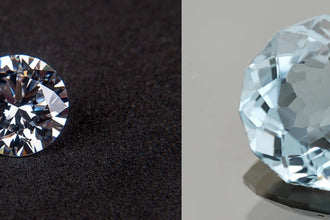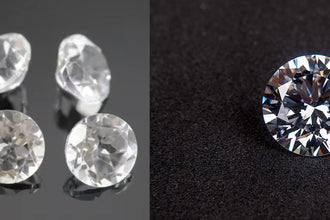
Diamonds have long been revered for their mesmerizing beauty, durability, and symbolism. Traditionally, natural diamonds have been the epitome of luxury and elegance. However, with advancements in technology, lab-grown diamonds have emerged as a fascinating alternative. This blog will delve into the world of diamonds, examining the key differences between lab-grown and natural diamonds, and shedding light on the pros and cons of each.

Origins: The Diamond Genesis
Natural Diamonds:
Formed deep within the Earth's mantle over millions of years, natural diamonds are the result of intense heat and pressure acting upon carbon atoms. They are brought to the surface through volcanic eruptions, creating the coveted gemstones that are highly valued in the jewelry industry. Each natural diamond carries a unique history, making it one-of-a-kind.
Lab-Grown Diamonds:
As the name suggests, lab-grown diamonds are created in controlled laboratory environments that simulate the natural diamond-forming process. These diamonds are grown using two different methods: High Pressure-High Temperature (HPHT) and Chemical Vapor Deposition (CVD). HPHT involves subjecting a diamond seed to extreme pressure and temperature, while CVD involves depositing carbon atoms onto a diamond seed using a carbon-rich gas.
Quality and Aesthetics: A Closer Look
Natural Diamonds:
The allure of natural diamonds lies in their inherent uniqueness and natural imperfections. These imperfections, known as inclusions, give each diamond a distinct character and are often seen as a testament to their natural origin. The traditional "4 Cs" (carat, cut, clarity, and color) are widely used to assess the quality of natural diamonds. The color grading ranges from D (colorless) to Z (light yellow or brown).
Lab-Grown Diamonds:
Lab-grown diamonds, on the other hand, are created under controlled conditions, allowing for a high degree of control over their quality and aesthetics. These diamonds can be produced with exceptional color and clarity, often surpassing the quality of natural diamonds. Lab-grown diamonds are typically labeled with the same grading system as natural diamonds, ensuring transparency and consistency in the industry.
Environmental Impact: Earth-Friendly Alternatives
Natural Diamonds:
The extraction of natural diamonds involves mining, which can have significant environmental consequences. The process of diamond mining requires extensive land clearance, leading to habitat destruction and soil erosion. Additionally, mining operations consume large amounts of energy and water, resulting in carbon emissions and water pollution. The impact on local communities and the potential for unethical practices within the industry further complicate the issue.
Lab-Grown Diamonds:
In contrast, lab-grown diamonds offer a more sustainable and environmentally friendly alternative. The production of lab-grown diamonds requires considerably less energy and water compared to mining. Furthermore, these diamonds do not contribute to the destruction of ecosystems or the displacement of communities. By choosing lab-grown diamonds, consumers can make an eco-conscious choice without compromising on the beauty or quality of the gem.
Affordability and Accessibility: Breaking Down Barriers
Natural Diamonds:
The scarcity and high demand for natural diamonds contribute to their exorbitant prices. Factors such as rarity, size, and quality determine the value of natural diamonds, making them inaccessible to many individuals. The allure of natural diamonds as a status symbol and investment further drives up the prices.
Lab-Grown Diamonds:
Lab-grown diamonds offer a more affordable and accessible option. The controlled production process allows for a steady supply of diamonds, reducing their cost compared to natural diamonds. This accessibility empowers a broader audience to own and enjoy the beauty of diamonds, challenging the exclusivity associated with natural diamonds.
Ethical Considerations: The Diamond Dilemma
Natural Diamonds:
The diamond industry has been marred by ethical concerns, particularly surrounding the issue of conflict or blood diamonds. These diamonds are mined in war zones and used to finance armed conflicts, human rights abuses, and environmental degradation. Although the Kimberley Process Certification Scheme was established to regulate the diamond trade and combat the issue, it has faced criticism for inadequate enforcement and loopholes.
Lab-Grown Diamonds:
Lab-grown diamonds provide a solution to the ethical quandaries associated with natural diamonds. By choosing lab-grown diamonds, consumers can be confident that their purchase does not contribute to conflicts or unethical practices. These diamonds offer a transparent and traceable supply chain, ensuring peace of mind for conscientious buyers.

Conclusion:
The choice between lab-grown diamonds and natural diamonds ultimately depends on personal preferences and values. Natural diamonds carry a legacy of time, rarity, and natural beauty, while lab-grown diamonds offer an eco-friendly, affordable, and ethically sound alternative. As technology continues to advance, lab-grown diamonds are poised to reshape the diamond industry, providing consumers with more choices and sparking important conversations about sustainability and ethics in the world of luxury.








krk jewels /
Lab-grown diamond jewelry is sustainable, affordable, and offers stunning brilliance and quality.
https://krkjewels.com/